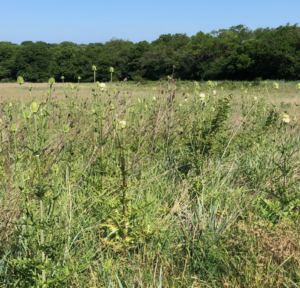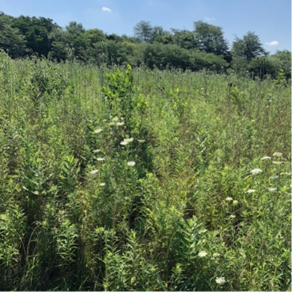SANITARY DISTRICT OF DECATUR NATIVE PRAIRIE MAINTENANCE
Between 1985 and 1990, the Sanitary District of Decatur established thirteen acres of restored native prairie on the west side of Dipper Lane. The District is now faced with constantly fighting an invasion of non-native and woody plants. Because this is not our area of expertise, the Sanitary District partners with the Macon County Conservation District to get advice and technical support in maintaining the prairie. There will be some extensive prairie maintenance over the next few months to address the invasion of non-native plants.
Prairie Maintenance
Prairie is no longer the peak ecosystem in the central Midwest. Left unmanaged, prairie eventually turns into woodland. This transformation is accelerated in fragmented landscapes in which tracts of land surrounding prairies function as reservoirs for seeds and fruits of woody plants and invasive species.
As with woody encroachment, non-native plants such as Common Teasel, Queen Anne’s Lace, Bush Honeysuckle, and Water and Poison Hemlock and Poison Sumac can be particularly challenging to control.
The pictures below are two examples of non-native plants that have made inroads in the prairie and need to be addressed.


Non-native Teasel invasion into the prairie. Non-native Queen Anne’s Lace.
Maintenance Tasks
Woody encroachment and non-native invasion cannot be effectively controlled with one method, so a suite of management activities is used to keep the prairie intact including mowing, selective use of herbicide, prescribed burning, overseeding and tree removal. These types of management activities are described below.
Mowing
Mowing is a valuable tool in the management of native prairies, especially where patches of woody brush or annual weeds are present. Mowing controls annual weeds and woody growth when combined with herbicide application and prescribed burns. Problem areas are mowed to a height of 8-12 inches after vegetation in such areas has reached a height of thirty inches. Mowing can be done with a rotary brush hog style mower to ensure that clippings are dispersed rather than deposited in dense mats, which smother vegetation. In areas that are too wet or too difficult to mow with a brush hog and tractor, weed whackers or brush saws can be used. For thickets of shrubs or stands of young saplings, a larger mower is required to remove the stems at or near ground level. An application of woody herbicide on the remaining stems improves the effectiveness of eradication efforts. In larger thickets or woody infestations, careful herbicide application to the leaves of the shrubs is performed, followed by subsequent applications after leaf-out. Once two or three foliar applications of herbicide are completed, the dead trunks are mowed down and piled up for burning in the spring.
Herbicide Application
Application of herbicide is used to control weedy growth and non-native colonizers that break through other management methods. Herbicide application follows instructions on the label, is performed by certified herbicide appliers, and is not used to remove desirable native vegetation.
Tree Removal
One of the first activities performed during the initial stages of prairie restoration is tree removal. Since the Sanitary District has an established prairie, tree removal is limited to small trees and can usually be accomplished through mowing.
Burning
Planned or prescribed burning is an indispensable tool to maintain and restore native grasslands. Fire controls woody growth, whether new seedlings or existing vegetation, while stimulating the growth of grasses and forbs, or wildflowers, in native grasslands or wetlands. Prior to a burn, a burn plan is prepared that outlines a plan of action, identifies contingencies, and lists the names and phone numbers of emergency agencies. Proper notice of intent to burn is given to local fire departments, and all required permits are obtained prior to the commencement of prescribed burning. Sometimes all the permit involves is contacting the local fire department or sheriff’s office prior to and after the burn. Prairie burns may be conducted in the spring to set back encroachment of woody plants and to invigorate native grasses adapted to periodic fire. Prairie burns are conducted in the fall to curb thick stands of grass and stimulate the germination of wildflowers—which typically begin to grow much earlier than prairie grasses.
Overseeding
The District will occasionally assist the native prairie compete with the non-native plants by applying a mix of seeds from native species without turning the soil. This overseeding helps create thicker desired vegetation when the prairie starts to show any signs of decline.
